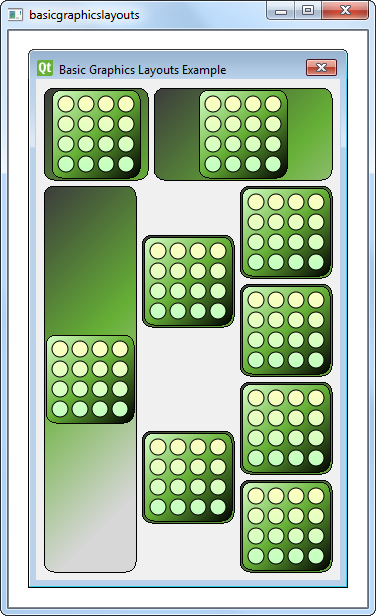Basic Graphics Layouts Example¶
Demonstrates how to create basic graphics layout.
The Basic Graphics Layouts example shows how to use the layout classes in
QGraphicsView:QGraphicsLinearLayoutandQGraphicsGridLayout. In addition to that it shows how to write your own custom layout item.
Window Class Definition¶
The
Windowclass is a subclass of QGraphicsWidget . It has a constructor with a QGraphicsWidgetparentas its parameter.class Window : public QGraphicsWidget { Q_OBJECT public: Window(QGraphicsWidget *parent = nullptr); };
Window Class Implementation¶
The constructor of
Windowinstantiates aQGraphicsLinearLayoutobject,windowLayout, with vertical orientation. We instantiate anotherQGraphicsLinearLayoutobject,linear, whose parent iswindowLayout. Next, we create aLayoutItemobject,itemand add it tolinearwith theaddItem()function. We also provideitemwith astretchFactor.QGraphicsLinearLayout *windowLayout = new QGraphicsLinearLayout(Qt::Vertical); QGraphicsLinearLayout *linear = new QGraphicsLinearLayout(windowLayout); LayoutItem *item = new LayoutItem; linear->addItem(item); linear->setStretchFactor(item, 1);We repeat the process:
create a new
LayoutItem,add the item
linear, andprovide a stretch factor.
item = new LayoutItem; linear->addItem(item); linear->setStretchFactor(item, 3); windowLayout->addItem(linear);We then add
lineartowindowLayout, nesting twoQGraphicsLinearLayoutobjects. Apart from theQGraphicsLinearLayout, we also use aQGraphicsGridLayoutobject,grid, which is a 4x3 grid with some cells spanning to other rows.We create seven
LayoutItemobjects and place them intogridwith theaddItem()function as shown in the code snippet below:QGraphicsGridLayout *grid = new QGraphicsGridLayout(windowLayout); item = new LayoutItem; grid->addItem(item, 0, 0, 4, 1); item = new LayoutItem; item->setMaximumHeight(item->minimumHeight()); grid->addItem(item, 0, 1, 2, 1, Qt::AlignVCenter); item = new LayoutItem; item->setMaximumHeight(item->minimumHeight()); grid->addItem(item, 2, 1, 2, 1, Qt::AlignVCenter); item = new LayoutItem; grid->addItem(item, 0, 2); item = new LayoutItem; grid->addItem(item, 1, 2); item = new LayoutItem; grid->addItem(item, 2, 2); item = new LayoutItem; grid->addItem(item, 3, 2); windowLayout->addItem(grid);The first item we add to
gridis placed in the top left cell, spanning four rows. The next two items are placed in the second column, and they span two rows. Each item’smaximumHeight()andminimumHeight()are set to be equal so that they do not expand vertically. As a result, these items will not fit vertically in their cells. So, we specify that they should be vertically aligned in the center of the cell usingAlignVCenter.Finally,
griditself is added towindowLayout. UnlikeaddItem(),addItem()requires a row and a column for its argument, specifying which cell the item should be positioned in. Also, if therowSpanandcolumnSpanarguments are omitted, they will default to 1.Note that we do not specify a parent for each
LayoutItemthat we construct, as all these items will be added towindowLayout. When we add an item to a layout, it will be automatically reparented to the widget on which the layout is installed.setLayout(windowLayout); setWindowTitle(tr("Basic Graphics Layouts Example"));Now that we have set up
gridand added it towindowLayout, we installwindowLayoutonto the window object usingsetLayout()and we set the window title.
LayoutItem Class Definition¶
The
LayoutItemclass is a subclass ofQGraphicsLayoutItemandQGraphicsItem. It has a constructor, a destructor, and some required reimplementations. Since it inheritsQGraphicsLayoutItemit must reimplement {setGeometry()}{setGeometry()} and {sizeHint()}{sizeHint()}. In addition to that it inheritsQGraphicsItem, so it must reimplement {boundingRect()}{boundingRect()} and {paint()}{paint()}.class LayoutItem : public QGraphicsLayoutItem, public QGraphicsItem { public: LayoutItem(QGraphicsItem *parent = nullptr); // Inherited from QGraphicsLayoutItem void setGeometry(const QRectF &geom) override; QSizeF sizeHint(Qt::SizeHint which, const QSizeF &constraint = QSizeF()) const override; // Inherited from QGraphicsItem QRectF boundingRect() const override; void paint(QPainter *painter, const QStyleOptionGraphicsItem *option, QWidget *widget = nullptr) override; private: QPixmap m_pix; };The
LayoutItemclass also has a private instance ofQPixmap,m_pix.
LayoutItem Class Implementation¶
In
LayoutItem‘s constructor,m_pixis instantiated and theblock.pngimage is loaded into it.LayoutItem::LayoutItem(QGraphicsItem *parent) : QGraphicsLayoutItem(), QGraphicsItem(parent), m_pix(QPixmap(QLatin1String(":/images/block.png"))) { setGraphicsItem(this); }We use the
Q_UNUSED()macro to prevent the compiler from generating warnings regarding unused parameters.void LayoutItem::paint(QPainter *painter, const QStyleOptionGraphicsItem *option, QWidget *widget) { Q_UNUSED(widget); Q_UNUSED(option); QRectF frame(QPointF(0, 0), geometry().size()); const QSize pmSize = m_pix.size(); QGradientStops stops;The idea behind the
paint()function is to paint the background rect then paint a rect around the pixmap.// paint a background rect (with gradient) QLinearGradient gradient(frame.topLeft(), frame.topLeft() + QPointF(200,200)); stops << QGradientStop(0.0, QColor(60, 60, 60)); stops << QGradientStop(frame.height() / 2 / frame.height(), QColor(102, 176, 54)); //stops << QGradientStop(((frame.height() + h)/2 )/frame.height(), QColor(157, 195, 55)); stops << QGradientStop(1.0, QColor(215, 215, 215)); gradient.setStops(stops); painter->setBrush(QBrush(gradient)); painter->drawRoundedRect(frame, 10.0, 10.0); // paint a rect around the pixmap (with gradient) QPointF pixpos = frame.center() - (QPointF(pmSize.width(), pmSize.height()) / 2); QRectF innerFrame(pixpos, pmSize); innerFrame.adjust(-4, -4, 4, 4); gradient.setStart(innerFrame.topLeft()); gradient.setFinalStop(innerFrame.bottomRight()); stops.clear(); stops << QGradientStop(0.0, QColor(215, 255, 200)); stops << QGradientStop(0.5, QColor(102, 176, 54)); stops << QGradientStop(1.0, QColor(0, 0, 0)); gradient.setStops(stops); painter->setBrush(QBrush(gradient)); painter->drawRoundedRect(innerFrame, 10.0, 10.0); painter->drawPixmap(pixpos, m_pix); }The reimplementation of
boundingRect()will set the top left corner at (0,0), and the size of it will be the size of the layout itemsgeometry(). This is the area that we paint within.QRectF LayoutItem::boundingRect() const { return QRectF(QPointF(0, 0), geometry().size()); }The reimplementation of
setGeometry()simply calls its baseclass implementation. However, since this will change the boundingRect we must also callprepareGeometryChange(). Finally, we move the item according togeom.topLeft().void LayoutItem::setGeometry(const QRectF &geom) { prepareGeometryChange(); QGraphicsLayoutItem::setGeometry(geom); setPos(geom.topLeft()); }Since we don’t want the size of the item to be smaller than the pixmap, we must make sure that we return a size hint that is larger than
m_pix. We also add some extra space around for borders that we will paint later. Alternatively, you could scale the pixmap to prevent the item from becoming smaller than the pixmap. The preferred size is the same as the minimum size hint, while we set maximum to be a large valueQSizeF LayoutItem::sizeHint(Qt::SizeHint which, const QSizeF &constraint) const { switch (which) { case Qt::MinimumSize: case Qt::PreferredSize: // Do not allow a size smaller than the pixmap with two frames around it. return m_pix.size() + QSize(12, 12); case Qt::MaximumSize: return QSizeF(1000,1000); default: break; } return constraint; }
© 2022 The Qt Company Ltd. Documentation contributions included herein are the copyrights of their respective owners. The documentation provided herein is licensed under the terms of the GNU Free Documentation License version 1.3 as published by the Free Software Foundation. Qt and respective logos are trademarks of The Qt Company Ltd. in Finland and/or other countries worldwide. All other trademarks are property of their respective owners.
